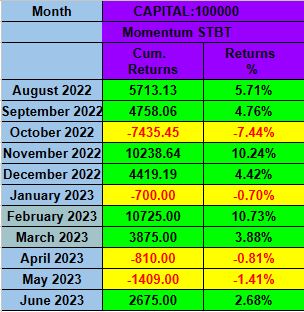Introducing the Sell Today Buy Tomorrow (STBT) Strategy
If you're looking to make your money work for you, even when you're not actively trading, our STBT strategy might be just what you're looking for. This strategy is a clever way to utilize your funds that would otherwise sit idle overnight. It's an ideal complement to any day-trading approach. Here's a breakdown of how it works and what you can expect:
1. What Is It?
The STBT strategy is a trading technique that involves selling options at the end of the day and buying them back the next morning. It's based on the momentum of the market and some complex financial principles, but you don't need to worry about those. Just know that it aims to make the most of small changes in price over short periods.2. Past Performance
Since 2016, the most significant loss (or drawdown) experienced was between 25 to 30%. It means that if you had invested, at one point, you might have seen your investment decrease by that much before potentially gaining again.3. Expected Returns
If you use this strategy by itself, you can expect a yearly return of 20 to 30%.
If you combine it with specific intraday strategies (like selling and buying on the same day using our Short Straddle approach), you might see returns of 28 to 42% per year.4. How Much Do You Need to Invest?
You would need a minimum of 1 lakh (100,000 in your currency) for each 'lot' or group of options you wish to trade. We recommend starting with at least 2 lots.5. When Do You Trade?
You'll sell your options at 3.25 PM every day (before the market closes).
You'll buy them back at 9.20 AM every day (when the market opens).6. Who Is This For?
This strategy is ideal for someone looking to take a more active role in their investments without having to monitor the markets all day long.
Final Thoughts The STBT strategy offers an interesting way to potentially grow your investment. Like all investments, it comes with risks, and past performance does not guarantee future results. If you're considering this approach, please consult with a financial professional to make sure it aligns with your financial goals and risk tolerance.
